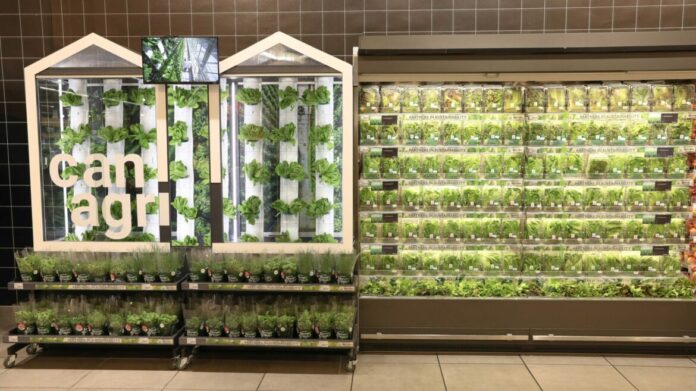Pick n Pay is the first retailer in South Africa to provide in-store “vertical farms” to demonstrate a sustainable and locally developed modern agricultural option to customers. In Pick n Pay’s fruit and vegetable department, the vertical farms will grow various lettuce leaves and herbs from seeds.
Supermarkets in Europe and the United States, like as Marks & Spencer (M&S) and Whole Foods Market, are introducing grown-in-store leaf as part of this novel farming approach display in-store.
The vertical farms are being tested first at Pick n Pay On Nicol in Sandton and Pick n Pay Constantia in Cape Town.
Vertical farming is a low-carbon, sustainable agricultural practice that uses 95% less water, 85% less fertilizer, and no pesticides.
The displays, according to Liz van Niekerk, Pick n Pay’s Head of Produce and Horticulture, should stimulate the curiosity of and strongly appeal to environmentally conscious customers, particularly the youth, who will be able to see firsthand how produce grows and help link them more to farming.
“Understanding the provenance of our food is really important, and having the opportunity to share this environmentally friendly way of delivering delicious, safe and sustainable produce with our customers, while they shop, is a huge opportunity.”
The effort is in collaboration with CAN-Agri, a Pretoria-based vertical, hydroponic greenhouse farm that has been supplying Pick n Pay with food under the PnP label for over three years.
The Pick n Pay-CAN-Agri in-store vertical farm features eight vertical ‘growing stacks,’ each with ten plants, and will serve as a practical demonstration of CAN-commercial Agri’s facility, which has 24 rows and 200 ‘growing stacks,’ reaching 6 meters in height. While CAN-greenhouse Agri’s maximizes sunshine, grow lights will be utilized in-store because the product will not be exposed to natural light.
While customers will not be able to purchase vegetables directly from the in-store vertical farms, CAN-Agri will supply a new line of items from its farm, which will be pre-packaged in recycled plastic punnets. Salad leaves with various lettuces and herbs, complete baby butter lettuce heads, and cos leaves will be included.
According to Francois van der Merwe, CEO of CAN-Agri, the in-store program is an excellent way to raise vertical farming awareness and educate customers about this unique farming approach.
CAN-Agri is a South African company that has developed and patented its own technology. Its 3200 m2 growing area can accommodate 384 000 plants. “We’ve harnessed innovative technologies to produce food more responsibly and efficiently, to meet the challenges and demands of years to come,” says van der Merwe.
According to the United Nations2, the global food supply will have to increase by 50% by 2050 to accommodate the projected demand for the world’s growing population. At the same time, there is an urgent need to cut greenhouse gas emissions but agriculture is one of the greatest contributors to global warming accounting for 24% of greenhouse gas emissions3 worldwide.
Van der Merwe says that vertical farming is expected to grow by 25.5% over the next eight years due to the increased demand for urban agriculture and adoption of environment-friendly production of fruit and vegetables1.
Van Niekerk says the retailer is always looking for alternatives to lessen its impact on the environment, and vertical farming is a way to help increase food supply of certain produce, in a more sustainable way.
Technology-driven, low-energy and sustainable vertical farming solution – how does it work?
Van der Merwe explains they grow their produce in a controlled sustainable environment which maximises viability to avoid food waste. “Everything is monitored, from seed to packet.”
Seedlings are grown in seed trays using bio-degradable baskets for three weeks in the nursery greenhouse before they are transplanted into grow tubes in the main greenhouse which has 24 rows spanning 6 meters high. Each row has 200 ‘growing stacks’ which grows 80 plants each.
“The growing stacks are strategically spaced in rows to allow for maximum sunlight. Purified, oxygenated, nutrient-rich water is fed through the top of the grow tubes, it then gravitates down through the tubes flowing over the roots of the plants and is recycled in a continuous closed-loop system.”
The growth stacks are also utilized to regulate the greenhouse’s climate. The nutrient-rich water is chilled or heated, and the grow stacks act as a big radiator by maintaining a consistent temperature.
He says their farming method also trebles the product’s shelf life. “Our produce is free of soil or insects so we don’t wash the produce. The normal washing process bruises and damages the produce, shortening its shelf-life”.
“The controlled growing environment delivers a consistent product and means we only harvest what is ordered. Our technology also helps us do many short growing cycles (three weeks) without any negative effect on our production output. Harvesting a younger plant also helps us deliver flawless leaves that just taste better.”
A QR code will be added onto the packaging later this year to let customers track their produce from seed to table. “Customers will be able to see where their food was grown, when was it planted, what were the environmental conditions it grows in, what nutrients it received, when was it harvested, packed, and supplied to the store,” says van der Merwe.


